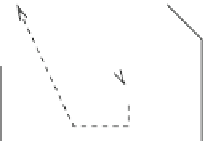Biomedical Engineering Reference
In-Depth Information
GF
ligand
TRCP1/3/4/6/7
TRPM4
RTK
GPCR
CNG/HCN RACC / SOC
sCG
NOS3−Cav1
PIP2
PLC γ
PLC β
cGMP
−
−
cAMP
Ca
NO
PKG
PKC
PKG
DAG
IP3
−
IP3R
Ca
cGMP
NO
Ca
ER
Fig. 9.3
Negative feedbacks resulting from: (1) membrane depolarization on Ca
2
+
entry caused
by cyclic nucleotide-gated (CNG) and/or hyperpolarization-activated CNG K
+
(HCN) channels
and (2) receptor-induced activation of endothelial TRP channels (Sources: [
895
,
896
]). Calcium
entry via receptor-activated cation channels (RACC) and/or store-operated Ca
2
+
(SOC) channels
stimulates endothelial nitric oxide synthase (NOS3). Under resting conditions, NOS3 is inactivated
due to its binding to caveolin-1. Nitric oxide activates soluble guanylate cyclase (sGC) that
produces cGMP messenger. Liganded G-protein-coupled receptors (GPCR) generate cAMP via
Gs and adenylate cyclase. Messengers cGMP and cAMP activate CNG and/or HCN channels that
cause membrane depolarization, which exerts a negative feedback on RACC and SOC channels. In
addition, PKG inhibits RACC and SOC channels. Endothelial TRP channels can be activated by
different stimuli to regulate vascular permeability, modulate vascular tone, and cell proliferation
and apoptosis. Ligands bind to GPCRs (ATP, bradykinin, acetylcholine, etc.) or receptor protein
Tyr kinases (RTK; growth factors) to activate PLC
β
or PLC
γ
that produce DAG and IP
3
agents.
Messenger IP
3
binds to IP
3
R on the membrane of the endoplasmic reticulum to release Ca
2
+
from
its store. Messenger DAG activates TRPC3, TRPC6, and TRPC7, as well as PKC. PKC inhibits
TRPC3, TRPC4, and TRPC6, but stimulates TRPC1 and TRPM4. The NO-cGMP pathway
primed by augmented cytosolic calcium level stimulates PKG that inactivates TRPC3, TRPC6,
and TRPC7, yielding a negative feedback.
TRPC4, and TRPC5 are store-operated channels, whereas receptor-operated
channels TRPC3 and TRPC6 are activated independently of store depletion.
Multiple heterologous combinations of TRPCs generate tetrameric channels (e.g.,
TRPC1-TRPC4, TRPC1-TRPC5, and TRPC3-TRPC6 complexes). In bovine
aortic endothelial cells, glucose enhances synthesis of canonical transient receptor
potential TRPC1 channel, but not that of TRPC3, TRPC4, and TRPC6 [
897
].
Endothelial Ca
2
+
-permeable receptor-activated cation channels, activated by an
increase in
Ca
2
+
]
i
, provide a positive feedback on their own activation, whereas
negative feedbacks are provided by mechanosensitive Ca
2
+
-permeable and/or cyclic
nucleotide-gated channels via NO and non-selective cation channels (Fig.
9.3
).
Ligand-gated Ca
2
+
channels, such as cyclic nucleotide-gated channels (CNGC),
43
[
43
Cyclic nucleotide-gated channels are non-selective cation channels that open on binding to
cyclic nucleotides, cyclic adenosine monophosphate (cAMP) and cyclic guanosine monophosphate
(cGMP). Although CNGC activity exhibits a small voltage dependence, CNGCs belong to



































Search WWH ::

Custom Search